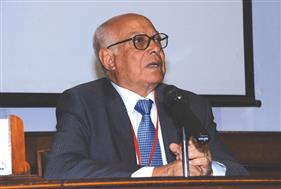German Textile Research InstitutesSnapshots Reported

Due to their unique scientific cooperation between both countries,
Egypt and Germany had a further fruitful step in July 2009. Prof. Dr. Ali Ali Hebeish , Head of the Egyptian National Campaign for Developing Textile Industries and Al NASGIH senior scientific advisor in Egypt was invited to visit many textile research centers in
Germany
. Dr. Hebeish`s visits included German Textile Research Center North-We st (DTNW ) , the Institute of Textile Technology and Process Engineering, (ITV) , Saxon Textile Research Institute (STFI) , and the Institute for Textile Chemistry and Chemical Fibers , denkendorf.
In reporting his overview, Dr. Hebeish assures that the research and innovation fields of textiles adopted by the German
institutes are carefully selected, ordered and integrated within the science and technology priorities in Germany
. Textile innovation seems to be in the score of science and technology strategy for knowledge-based development. «This, indeed explains the fact that Germany occupies the first position in production of technical textiles all over the world» he adds.
During his visit to DTNW , several topics were addressed with prominent figures . Among other , discussions covered the importance of modification of textile fibre surfaces and the use of supermolecular chemistry, supramolecur chemistry, especially dendrimers and modern physics to develop the textiles in general and technical fibres and smart textiles in particular .
After meeting Prof. Dr. Heinrich Planck , director of
Institute of
Textile Technology
and Process Engineering (ITV) , denkendorf , Prof Hebeish recognized that ITV focuses on traditional fabric manufacturing processes and ecology of production as well as on development of nonwovens and their applications. Further , New coating technologies are developed for production of innovative textiles with unique surface characteristics. Besides, ITV has successfully established a centre of excellence for technical textiles.
«Over the last thirty years important developments have been observed at Saxon Textile Research Institute (STFI)» clarifies Dr. Hebeish . For a long time, the innovation process has been seen as a linear process. Upstream of this linear process was basic research, the sole objective of which was to develop new knowledge, which was then filtered by applied research for use in developing new products or processes. Innovation was seen as a result of sequentially
trans-forming scientific knowledge into new goods and services. He adds that STFI is involved in several national projects. One of the latter is « MaliTe -
Stitch-bonded Fabrics and Web knitte¬d Fabrics for Technical Textiles». Another project is «Risk Management of Extreme Flood Events», including : self sealing water barrier, sensor-based geotextiles for dike, reinforcement and stabilizing river dikes prone to failure by ceasing drainage elements for reinforcement and interception of
seepage water and drainage. A third project is dealing with « Innovative Regional Growth Core high Stick» which is targeted to building textiles, mobile textiles and medical textiles. Other projects aim at development of sensor-based textile, reinforcement, panel heat systems and cooling pack. STFI is also involved in three projects within the framework of European activities.
While visiting the Institute for Textile Chemistry and Chemical Fibers (ITCF) , Prof. Hebeish witnessed that ITCF adopts three research fields : the first is concerned with innovative textile finishing processes and chemistry of technical textiles. Research actives include coating, laminating, surface treatment using plasma, ultraviolet radiation or electron beam. Special attention is also given to smart textiles including photocromic, electrolumiscent, conductive,
The second ITCF,s research field deals with chemistry, physics and
technology of fibre production. This field covers synthesis of fibre polymers; spinning technology including melt, wet- and dry spinning; synthetic and cellulosic fibres and special yarns such as flame retardant, hydrophilic, hydrophobic, antistatic, fibres from blends and structural investigation of fibres.
The third research field of ITCF addresses intelligent textile materials and high performances fibres. This field is targeted to develop fibre polymers containing nanoparticles, functional nanofilters in coating and nanostructured surfaces; carbon fibres based on PAN-precursors; oxide and non-oxide ceramic fibres; conductive, piezoelectric and
magnetic fibres and adaptive textiles and textile based solar cells.

